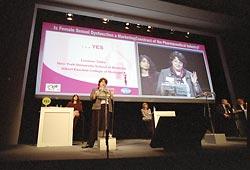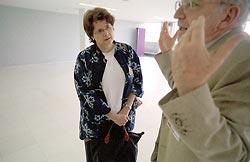Originally published June 30, 2005 at 12:00 AM | Page modified March 16, 2010 at 4:54 PM
Clash over "little blue pill" for women
After Viagra's blockbuster success, some medical experts pushed for a similar drug for women — and encountered resistance from colleagues who questioned whether the scientific foundation was solid enough.
Seattle Times staff reporter
HARLEY SOLTES / THE SEATTLE TIMES
When medical experts came to Paris in 2003 to define sexual dysfunction for women around the world, drug companies were there, too. An attendee at the Second International Consultation on Erectile and Sexual Dysfunctions signs up for free drawings at Pfizer's Blue Diamond Club, which promotes the drug Viagra. Pfizer and other drug companies are interested in creating a market for female-sexual-dysfunction medicines.
HARLEY SOLTES / THE SEATTLE TIMES
During the Paris conference, psychologist Leonore Tiefer, a New York University professor and expert on women's sexuality issues, speaks for the "yes" side during a debate on the topic: "Is Female Sexual Dysfunction a Marketing Construct of the Pharmaceutical Industry?"
HARLEY SOLTES / THE SEATTLE TIMES
Psychologist Leonore Tiefer, an outspoken critic of the pharmaceutical industry's influence on doctors, argues with Dr. Saad Khoury, a Paris urologist, during the Paris conference.
If a woman isn't as interested in sex as she used to be, is she sick?
According to some experts, the answer is yes — as long as the woman's decline in desire bothers her.
Those experts, backed by drug companies, for years have been pushing the medical establishment to incorporate that sort of standard into a new definition for a condition called "female sexual dysfunction," or FSD.
Today, FSD has all the trappings of a well-established disease: spokespeople, alarming statistics, a political lobby, a medical specialty and an academic journal. Drug companies are developing a mountain of medicines to serve the new market.
FSD is a case study in how researchers financed by pharmaceutical companies can try to turn problems into an expanded disease, creating a market for drugs, even when those problems are not well understood.
Even more so, the story of FSD demonstrates how some medical professionals are pushing back, challenging those who define disease to back up those definitions with hard scientific evidence.
It all started with the "little blue pill."
Viagra side effect?
Drug for men spurs interest in developing one for women, too.
The focus on women's sexual problems was fueled by the development of Viagra, the male-impotence drug that has generated billions of dollars in sales for Pfizer.
Female sexual dysfunction: Chronology of drug development and sales
In 1997, as Viagra was nearing Food and Drug Administration approval, a Pfizer consultant invited doctors to gather with drug-company officials in Cape Cod, Mass., to discuss opportunities for researching women's sexual dysfunction.
"The meeting is completely supported by pharmaceutical companies, and approximately half of the audience will be pharmaceutical representatives," the organizer, psychologist Raymond Rosen of the Robert Wood Johnson Medical School in New Jersey, wrote in the e-mailed invitation, later quoted in the British Medical Journal.
"The goal is to foster active and positive collaboration between the two groups. Only investigators who have experience with or special interest in working collaboratively with the drug industry have been invited."
Meanwhile, in March 1998, the FDA approved Viagra for use in impotent men. The drug increased blood flow to the genitals. Sales were instantly enormous, and the sex lives of many impotent men and their partners were changed.
The drug industry and some doctors wondered: Could the medical and financial success of Viagra be replicated for women?
Before Viagra could be approved for use in women, there had to be a well-defined disease that it could treat. With men, the malady was physically and visibly obvious. For women, sexual dysfunction was not nearly so clear-cut.
In its reference manual, the American Psychiatric Association described FSD as a condition comprising four main disorders: decreased desire, decreased arousal, painful intercourse and difficulty having orgasms.
Treatment mostly consisted of psychotherapy and counseling. Some physicians were prescribing estrogen as well as off-label, or unapproved, use of testosterone to women for sex-related problems. Now some began prescribing Viagra even though no data existed for its safe use in women. Nor were there any studies showing that increased blood flow to a woman's genitals would increase arousal.
In October 1998, the American Foundation for Urologic Disease gathered 19 experts in Boston to take a crack at writing a new definition for FSD that could make room for drug treatment and research.
Eight drug companies paid for the meeting. Eighteen of the 19 experts had financial ties to drug companies. Many of them had been involved in Viagra research.
Only two gynecologists — the medical specialty most associated with women's reproductive health — were included.
In Boston, the 19 experts added "personal distress" as a component of FSD. For example, if a woman was distressed by her lack of interest in sex, she would have a form of FSD. If she wasn't distressed, no disease.
That meant two women could have exactly the same physical symptoms but a different diagnosis, depending on how they felt about it.
Some critics — among them psychotherapists and women's rights groups — seized on the "personal distress" component, saying it was medically unsound and would encourage drug sales by undermining women's confidence in their sex lives.
Others said the definition implied there was a standard of "normal" sexual functioning, even though no such standard had been scientifically established.
Even some of the experts who signed off on the new definition didn't entirely agree with it. "We reached consensus but some of the things we decided on were against people's philosophies," said one of the experts, Canadian gynecologist Rosemary Basson.
Critics feared that otherwise healthy women, once they admitted to unhappiness with their sex lives, might be labeled with a disease and simply prescribed drugs.
Four months later, Rosen and a colleague published a study that said 43 percent of American women surveyed had experienced "sexual dysfunction" for several months in the previous year.
The controversial figure has been widely quoted in the media and touted by the drug industry.
Battle lines drawn
FDA drafts guidelines about what FSD drugs must do.
Those debating what FSD was and how to treat it split, in general, into two camps, each with its own approach. Feminist mental-health experts and therapists were on one side; on the other were corporate-sponsored researchers and doctors, particularly urologists who had seen how a new drug transformed their practices.
Drug companies had other Viagra-like drugs in development, and in May 2000 the FDA drafted guidelines that told them where the agency was setting the bar for a drug to be considered effective in treating FSD. The agency said a new drug would have to show "clinically significant changes in the number of successful and satisfying sexual events experienced by a woman."
The critics were alarmed. Members of "The New View Campaign," a network of feminists and others, said pharmaceutical marketing was oversimplifying sex as a mechanical process, while ignoring that a woman's sexual health was shaped by her upbringing, her relationship with her partner, and other social forces.
Sexual satisfaction for women shouldn't strictly be defined by the numbers of successful sex acts, said Jennie Popay, a sociology and public-health professor at the Institute for Health Research at Lancaster University in England.
"If you claimed you had one pill that cured all mental disease, they'd laugh at you," she said. "But that's really what they're talking about here: one pill, a woman's Viagra. You create a single universal disease category and look for a single silver bullet."
Therapist Laura Berman, director of a women's sexual-health center in Chicago, said that, in general, urologists had seized the initiative and set a more drug-friendly agenda, bringing along like-minded psychologists.
"There were a couple of people early on who had a loud voice and funding behind them ... ," Berman said. "They took the ball and put the people in place."
The most influential "loud voice" was Dr. Irwin Goldstein, a Boston urologist and admitted workaholic who consulted for Pfizer on Viagra and has played a leading role in trying to define FSD.
A definition delayed
Evidence overwhelms expert opinion.
Goldstein was among those attending a crucial meeting involving FSD in Paris in June 2003. The gathering was the Second International Consultation on Erectile and Sexual Dysfunctions.
Also in attendance was psychologist Leonore Tiefer, a New York University professor, expert in women's sexuality issues and a leader in "The New View Campaign."
Goldstein and his colleagues at the conference hoped to hammer out a definition of and treatment guidelines for FSD that could be used to treat women around the globe.
He was optimistic that, finally, women's sexual problems would get the same attention that men's had, Goldstein said in an interview at the conference. Women's sexual health was so neglected that doctors lacked even basic knowledge about women's desire and how they get aroused, Goldstein said.
"If you don't have a definition, you don't have an answer," he said.
Tiefer, a scientific adviser at the conference, participated in a debate there but was not part of the committee working on defining FSD.
The million-dollar conference was funded largely by three drug companies that make anti-impotence drugs. Pfizer, Bayer Pharmaceuticals and Lilly/Icos together paid $1,600 travel stipends to about 200 of the experts, the conference organizer said.
Drug-company executives were at the Paris meeting, too. Conference organizer Dr. Saad Khoury, a Paris urologist, said companies had paid more than $600,000 for the privilege of promoting their products and mingling with the more than 1,000 attendees, including those experts writing the FSD definition.
The drug firms paid $50,000 to present such lectures as "Levitra's Contribution to Sex and Society" and "The Impact of Viagra over 5 years: Why is it a Worldwide Phenomenon?"
Bayer offered attendees a quiet meeting space in a lounge decorated with ancient stone phalluses. Pfizer gave doctors espresso and Internet access in a private cafe. Through it all, tour buses bearing placards with the companies' names took the attendees to dinner around Paris.
Khoury said he was aware the drug companies' involvement in Paris could undermine confidence in the experts' recommendations. To guard against that, he said, the conference required that the experts rely on "evidence-based medicine."
The Centre for Evidence-Based Medicine at Oxford describes the process as "the shared objective of wanting to maximize the help and minimize the harm we do to patients by basing our clinical decisions on the sorts of evidence that are least likely to be wrong." That meant studies are based on clinical data and test results, not solely on the opinions of experts.
Using the evidence-based principle, the experts at the Paris meeting assigned grades of A to D to each of the recommendations coming from the conferences. The grades corresponded to the quality of scientific data supporting each recommendation.
Toward the end of the Paris conference, Basson, the Canadian gynecologist, gave a progress report to a full auditorium of attendees. She summarized the recommendations and their grades.
The five drug-treatment recommendations — for instance, using testosterone to increase desire — were all rated C or lower.
Based on the evidence, she said, scientists didn't know enough about women's sexual functioning to give authoritative treatment advice.
The Paris gathering of experts raised more questions than answers. But participants did agree on parts of the FSD definition and said the final official version would be worked out over the coming months.
Tiefer, the NYU professor, was glad to hear that a lot more evidence would have to surface before women's sexual problems would be treated with drugs.
Goldstein was also pleased. The group did recommend that women who complained of sexual problems first get a physical exam. He viewed the recommendation as an acknowledgement that women's sexual problems have a physical component.
Tiefer and Goldstein both called the conference results historic, and it seemed, for the moment at least, that the two experts and their respective camps had found common ground.
Battle reignites
More drugs in pipeline for FDA approval.
Within months of the Paris conference, though, Tiefer was back on high alert. The new FSD definition and guidelines, based on the work of the Paris conference, had been completed and published in the July 2004 issue of The Journal of Sexual Medicine, which Goldstein edits. The article was intended to be used as guidance for physicians treating patients complaining of sexual problems.
Contrary to what was said in Paris, the expert panel based its published work not just on evidence-based research but used expert opinions for "refining the recommendations," Khoury said. Among other things, the panel called for the investigational use of Viagra-type compounds and testosterone to treat women's sexual problems.
Meanwhile, another new drug appeared on the scene: Intrinsa, a testosterone patch its manufacturer said increased the sexual desire of women whose ovaries and uterus had been removed and were taking estrogen therapy.
In asking for FDA approval, the manufacturer, Procter & Gamble, said Intrinsa would treat a form of FSD called "hypoactive sexual desire disorder." The company defined the disorder this way: a decline in sexual desire, which leads to fewer satisfying sexual encounters and causes a woman personal distress.
Although the manufacturer's application sought approval to use the drug only in women without ovaries, Tiefer and others believed Procter & Gamble had a wider market in mind.
New York gynecologist Sharon Diamond, who attended a continuing medical-education course sponsored by Procter & Gamble last September, e-mailed Tiefer that the company was "clearly promoting off-label use for all post-menopausal women with this 'disorder.' "
A company spokesman, Tom Milliken, said, "We would never promote off-label indication for our drugs."
In December, the FDA held a hearing in Washington, D.C., on whether to approve Intrinsa. Tiefer and others testified against approval.
"Intrinsa is not a glass of Chardonnay" but a powerful drug, she said, that might be promoted as "the female Viagra."
The FDA advisory committee determined that the patch was a marginally effective treatment for that form of FSD. The committee based its decision on clinical trials that showed women who wore the patch went from three satisfying sexual experiences a month to five — one more than those women taking placebos.
But the committee voted unanimously against approving Intrinsa because of safety concerns about unknown effects of long-term use of testosterone in women. Some committee members said they were concerned the drug might be prescribed to women for whom it was not approved.
Tiefer went back to her Maryland hotel room to celebrate with friends. But today, six months after the FDA turndown, she remains concerned.
Procter & Gamble said it has not given up on the drug Intrinsa. The company and other drug makers have at least 25 other drugs in the approval pipeline that are designed to treat women's sexual problems.
Send comments to suddenlysick@seattletimes.com or call Susan Kelleher: 206-464-2508.
Entertainment | Top Video | World | Offbeat Video | Sci-Tech
general classifieds
Garage & estate salesFurniture & home furnishings
Electronics
just listed
More listings
POST A FREE LISTING








